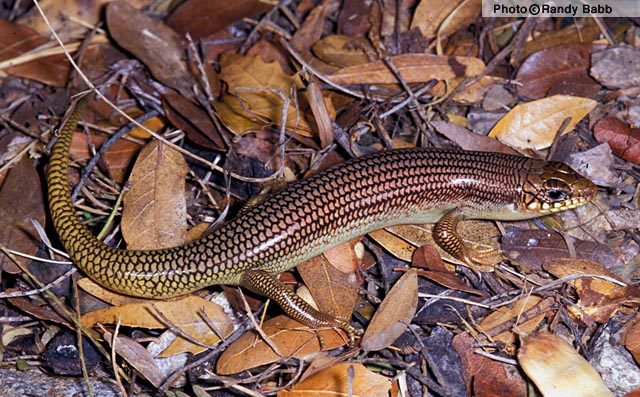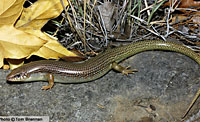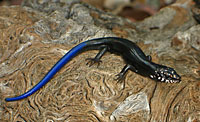Online Field Guide to The Reptiles and Amphibians of Arizona



Adult. Cochise County, AZ
 Cochise Co., AZ |
| GREAT PLAINS SKINK Plestiodon obsoletus | |
|
DESCRIPTION: A large (up to 133 mm or 5.6″ from snout to vent), shiny lizard with a long, thick tail (when not regenerated), a stout body, and short limbs. Base coloration is tan, cream, gray, or olive. A dark crescent marks the back edge of each scale creating a net like pattern over the body, limbs, and tail. Some specimens have reduced black markings consisting of sporadic spots and flecks. On some animals the black markings merge together creating patches or rough lines. The limbs and tail are tinted with yellow or yellow-orange. Orange or salmon spots usually mark the lower sides of the body. The back is often tinted with pink or mauve. The underside is plain and cream colored. Young are jet black with a bright blue tail, white or yellow spots on the lips, and a plain gray underside. The scales of this lizard are large, rounded, smooth, and very shiny. Its dark crescent-shaped markings distinguish it from the similar looking Gilbert’s Skink. HABITAT: The Great Plains Skink inhabits a variety of communities including Semidesert Grassland, Interior Chaparral, Madrean Evergreen Woodland, Great Basin Conifer Woodland, and the lower reaches of Petran Montane Conifer Forest. It is strongly associated with mesic environments such as river corridors, canyon bottoms, drainages, and moist grasslands. BEHAVIOR: Primarily diurnal but occasionally active on warm nights in southern Arizona. This ground-dweller is usually only surface active in well shaded areas, on mild mornings, or on moist overcast days. It shelters in burrows or in moist areas under logs, rocks, leaf litter, or other surface debris. When spotted it can be quite difficult to capture as it quickly slides and zigzags through the rocks and surface debris. It is capable of casting off (and regenerating) the tail. Pursuers and predators often end up with nothing but a wiggling tail. When captured it does not hesitate to bite. DIET: The Great Plains Skink eats a variety of insects including grasshoppers, caterpillars, crickets, roaches, and beetles. It also feeds on spiders, snails, and small lizards. REPRODUCTION: This lizard lays a clutch of up to 24 eggs in late spring or summer. Eggs are laid in an underground nest, usually below an imbedded rock or log. The female stays with the eggs and guards them for the entire 4 to 8 week incubation period. Hatchlings begin to emerge in early summer. By Thomas C. Brennan Brennan, T. C., & A. T. Holycross. 2006. A Field Guide to Amphibians and Reptiles in Arizona. Arizona Game and Fish Department. Phoenix, AZ Brennan, T. C., & A. T. Holycross. 2005. A Field Guide to Amphibians and Reptiles of Maricopa County. Arizona Game and Fish Department. Phoenix, AZ Stebbins, R.C. 2003. A Field Guide to Western Reptiles and Amphibians, Third Edition. Houghton Mifflin Company, Boston, MA. |
|
Visit Partners in Amphibian and Reptile Conservation:


HOME
Copyright © 2023, Arizona Game and Fish Department. All rights reserved.
If you make use of the textual contents of this site in reports, publications, etc. please cite and credit the author(s) and photographer(s). All photos on this website are copyrighted. However, those found in the species account section may be used for any noncommercial scientific, educational, or conservation purposes provided that photographs are not altered and continue to bear the copyright symbol and name of the photographer. Please contact the photographer regarding commercial use of copyrighted photographs.











